How To Set Up A Hole Puncher
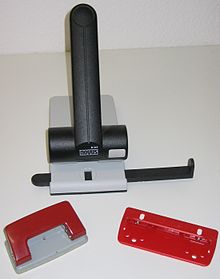
Three different styles of hole punch
A hole punch, also known as hole puncher, or paper puncher, is an office tool that is used to create holes in sheets of paper, frequently for the purpose of collecting the sheets in a binder or folder. A pigsty dial tin can also refer to similar tools for other materials, such as leather, textile, or plastic or metal sheets.
Machinery [edit]
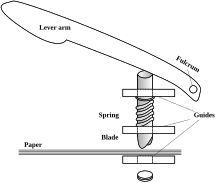
Mechanism of a typical hole punch
The essential parts of a hole dial are the handle, the dial caput, and the dice. The punch caput is typically a cylinder, with a flat end called the face. The die is a flat plate, with a hole matching the caput. The head can move, while the die is stock-still in place. Both head and die are ordinarily made of a hard metal, with precise tolerances. One or more than sheets of paper are inserted betwixt the head and the die, with the apartment face of the head parallel to the surface of the sheets. Moving the handle pushes the caput straight through the sheets of paper. The hard border of the punch vs the dice cuts a hole in the paper, pushing the cut piece out the bottom of the dice. The cut-out bit of newspaper scrap is called a republic of chad.
The handle functions as a lever, decreasing the amount of force the operator needs to apply. The travel distance of the cylinder is generally very short -- the thickness of the paper sheets -- so the cylinder can exist positioned close to the lever fulcrum. For low-volume hole punches, the resulting lever handle need not be more than 8 centimetres (3.ane in) long for sufficient force. Hole punches for larger volumes of newspaper (hundreds of sheets) feature longer lever arms, but part similarly.
There are hole punches which punch patterns of multiple holes at once, typically for bounden multiple sheets together (meet § Applications). Such punches generally feature 2 paper guides for alignment. I guide will be along the side of the paper to be punched, and sets the distance of the holes from the edge of the paper (the margin or gutter). The other guide will be on a perpendicular side, and aligns the holes between the peak and lesser of the sheet. One or both guides may exist adjustable.
On multiple-pigsty punches, the positions of individual punch heads may besides be adjustable. Commonly, i or more dial heads are mounted in contained fittings, which tin slide along a rail. A set spiral holds each fitting in position. In that location may be marks on the device to identify standard hole positions. There may be positions where a dial caput will not make contact with the activating handle, allowing holes to be "turned off".
Some punch designs employ hollow punch heads (a thin-walled tube), with the edge a sharpened bract. This allows the chads to be pushed up and out the superlative, every bit the newspaper is being cut, making information technology more than suitable for thicker volumes of paper. For very large amounts of newspaper, a newspaper drill may be used instead of a dial.
Applications [edit]
Single-hole punches [edit]

Common handheld single-hole dial
A single-pigsty punch makes a single pigsty per activation, normally at an arbitrary position (i.e., without alignment guides).
Single-pigsty punches are frequently used to punch an access ticket or other document to point it has been used or processed. A specialized ticket punch may exist used for this purpose. Some ticket punches have a longer reach/depth (allowing for a particular spot on the ticket to be punched), or punch a item shape instead of a round pigsty.
Single-pigsty punches are oft used to dial holes through quondam playing cards at casinos, mark them as "used" or "canceled". This helps cut down on cheating past eliminating whatever cards that may accept been tainted past players.
Unmarried-pigsty punches are widely used in the Britain Civil Service where papers are punched with a single hole in the upper left, and secured using a treasury tag.
Single-hole punches can also be used for binding, with a single loose bounden ring, although this is much less common than with band binders.
Single-pigsty punches can too exist used to make confetti for scrapbooks and other crafting.
Eyelet punch [edit]
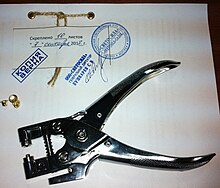
A related role tool is the eyelet dial. This is a single-pigsty punch which also crimps a metal fastening loop effectually the hole, similar to a rivet. It is used to permanently secure a few sheets of paper together.
A like tool, more often than not known as a holing pincer, is used in beast husbandry. A common application is to adhere an ear tag to a livestock fauna.
Paper tape repair punch [edit]
Specialized manus-operated tape punches were used to perform small edits and repairs on punched newspaper tapes used for information entry into teletypes or early computers. Torn or damaged tapes were sometimes aligned with specialized jigs, spliced with special agglutinative record, and the holes encoding data were manually restored using such punches. The ASCII character code included a special DELETE or DEL character defined as all holes punched out (code 7F), allowing an erroneous character to be canceled by punching extra holes.
Equally punched record technology became obsolescent in the 1980s, the manual tape repair tools became rare.
Multiple-hole punches [edit]
Multiple-pigsty punches typically place a blueprint of holes along ane edge of sheets of paper, allowing the pages to be spring together.
The most common use for multi-hole punched paper is with a band binder. A book-like cover is fitted with retaining rings matching the pattern of the punched holes. The rings may be split open, paper sheets threaded onto them, then the rings airtight over again.
A variety of hole patterns are in use for ring bindings. In much of the globe, 2-pigsty and iv-pigsty punches consequent with ISO 838 are the norm. In the The states, the three-hole punch is most common. See § Standards.
There are other binding techniques which use pigsty punching. Coil binding uses a spring-like coil, threaded into the punched holes. Comb binding uses a plastic strip with "fingers" that clip into the punched holes. Both use their own types of specialized hole punches. Comb binding typically punches 19 or 23 rectangular holes (for letter of the alphabet and A4 paper sizes, respectively).
-
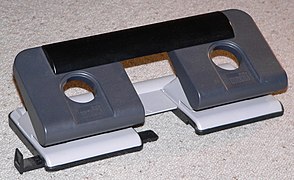
High german four-hole punch
-

23-pigsty punch
History [edit]
The origins of the pigsty punch date dorsum to Frg via Matthias Theel, where two early patents for a device designed to "punch holes in newspaper" have since[ when? ] been discovered.[1] Friedrich Soennecken filed his patent on fourteen November 1886, for his Papierlocher für Sammelmappen, a multiple-hole punch and office supply product.[2] A Google Doodle was used on 14 Nov 2022 to celebrate the 131st anniversary of the hole dial.[3]
The first record for a single-pigsty puncher—a ticket punch—was published in 1885, when Benjamin Smith helped create a spring-loaded hole puncher that had a receptacle to collect the chads. Smith dubbed it the "conductor's punch". A afterward paper punch was refined in 1893 past Charles Brooks, and it was referred to as a ticket punch due to its early office in punching train tickets as trains became increasingly popular and common between 1850 and 1900.[4]
Concerns accept risen about the lifespan of the hole punch as most paper documents are now online, making the use of it irrelevant.
Standards [edit]
Multiple standards exist for the number and position of holes on multi-punched sheets.
International [edit]
ISO 838 [edit]

International Standard ISO 838 specifies two holes, with centers 80±0.five mm apart, and located 12±one mm from the nearest edge of the paper, and with the pair of holes positioned symmetrically forth that edge. Each pigsty is to have a bore of 6±0.5 mm. Any paper format that is at least 100 mm high tin can be filed using this system (due east.g., ISO A7 and larger). A printed certificate with a margin of twenty–25 mm will accommodate ISO 838 filing holes.
iv-hole or 888 [edit]
A four-hole extension to ISO 838 is also in common use. Two holes are punched in accordance with the standard, plus two additional holes located 80 mm to the outside of the standard holes. The two additional holes provide more stability in iv-ring binders, while still allowing 4-pigsty newspaper to fit 2-ring binders. This extension is sometimes referred to as the "888" system, because of the three 8-cm gaps between the holes. Some 2-hole punches accept an "888" mark on their newspaper guide, to assist punching all four holes into A4 newspaper.[5]
Konica-Minolta specifies that the holes should be 11±1 mm from the edge of the paper[half-dozen] for European four-hole arrangements, reverse to ISO 838.
ANSI paper sizes [edit]
The Usa and a few other countries use not-ISO paper standards, defined in ANSI/ASME Y14.ane and other intra-nation standards. Unlike ISO 838, there appears to be no well-established official specification for ANSI paper pigsty patterns, and instead they are de facto standards, established by custom and tradition.
The diameter of the holes varies betwixt manufacturers, with typical values beingness 1⁄4 to five⁄16 inch (6 to eight mm). The five⁄16 value is most ordinarily used, every bit information technology allows for looser tolerances in both ring binder and paper punching. The altitude to the newspaper border also varies, with 1⁄two inch (13 mm) hole-center-to-border being typical. Konica-Minolta specifies 9.5±1 mm [6] for both two and 3-pigsty variants in North America.
US alphabetic character 3-hole arrangement [edit]
For the Usa letter newspaper size (8+ 1⁄ii by 11 inches, 220 by 280 mm), a three-hole standard is widely used. The holes are positioned symmetrically, with the centers four+ 1⁄4 inches (108 mm) apart. Information technology requires paper formats that are at least ix+ 1⁄2 inches (241 mm) high.
United states of america legal iv-pigsty system [edit]
For U.s. legal newspaper size (8+ 1⁄2 by 14 inches, 220 by 360 mm), a 4-hole system exists. It is however in use today, but is non as common as the three-pigsty standard. The four holes are positioned symmetrically with centers 3+ ane⁄two inches (89 mm) apart. The 4 binding positions provide more back up for the longer 14-inch side of legal paper.
2-hole filebinder [edit]
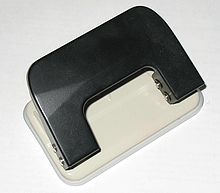
Two-hole filebinder pigsty punch
Some other standard also occasionally used in the US is a "filebinder" arrangement. Its ii holes are positioned symmetrically, with the centers 2+ 3⁄4 inches (70 mm) autonomously.
Nippon [edit]
In Japan, loose leaf in A4 and JIS B5 sizes (for binders) usually has 30 and 26 holes respectively according to the standard JIS Z 8303 (department 11); which specifies holes of 6±0.5mm of bore, with their centers every nine.5±1 mm, and a distance of half-dozen.5±0.5 mm from the centre of the holes to the edge of the paper with the additional brake that the holes must be placed in positions symmetric to the axis across the middle of the folio.[vii]
Swedish triohålning [edit]
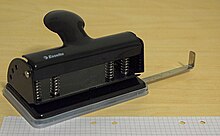
Triohålning punch and punched paper
In Sweden, a four-hole national standard[8] is near exclusively used. The centers of the holes are 21 mm, lxx mm and 21 mm apart, 10.5±0.v mm from the border of the newspaper. The guides assistance keep the paper in a straight line.
The official name of this four-hole organisation is triohålning, since it was adjusted to the "Trio binder" which was awarded Swedish patent in 1890. The folder's inventor, Andreas Tengwall, supposedly named it after a consortium consisting of himself and two companions, i.e. a trio.[ citation needed ] The folder can be opened at any identify while property the papers in place, as the inner holes have guide pins from ane side, the outer holes have pins from the other side.
Others [edit]
- The Filofax system uses six holes in 2 groups of iii
Pigsty spacing chart [edit]

Ordinarily used pigsty patterns for hole punches and ring binders[9]
Gallery [edit]
-

Antiquarian Soennecken hole punch
-

Antique heavy-duty Soennecken hole punch
-
Swedish hole punch
-
German Leitz hole punch
-

Japanese unmarried-hole punch
-

Closeup of punch with blue plastic chad collector
-

Single-hole punch for newspaper
-

Paper punched with seven holes, in a four-band binder
-

A hole punch in use
See as well [edit]
- Ticket punch
- Needle dial
- Chad (paper)
- Paper drilling
- Ring binder
- Punched carte
- Punched tape
- Punching
References [edit]
- ^ Xaver Frühbeis (xiv Nov 2000), Renate von Walter (ed.), Geburtstag des Lochers [Birthday of the Punch] (RTF) (in German language), Bayerischer Rundfunk, archived from the original (RTF) on 2004-09-02
- ^ , Photographs by Helmut Uessem, "Soennecken", Poppelsdorfer Heimatsammlung Stöcker, 2001-04-23, archived from the original on 2022-07-19, retrieved 2008-02-14
{{commendation}}: CS1 maint: others (link) - ^ 131st Anniversary of the Hole Puncher, Drawing by Gerben Steenks, 14 November 2022, archived from the original on 2022-08-20, retrieved 14 November 2022
{{citation}}: CS1 maint: others (link) - ^ Clark Mindock (xiii Nov 2022), "Hole dial history: How the earth became more organised in a single thadumph", The Contained, archived from the original on 2022-04-21, retrieved 2021-12-22
- ^ Markus Kuhn (2018-07-thirteen), International standard paper sizes, archived from the original on 2022-12-05, retrieved 2019-08-08 ,
Not specified in ISO 838, but besides widely used, is an upwards compatible 4-hole system. Its two centre holes correspond to ISO 838, plus in that location are 2 boosted holes located 80 mm above and beneath these to provide for more than stability. This way, sheets with four punched holes can besides exist filed in ISO 838 two-hole binders. This system is besides known under the nickname "888", presumably because the iii gaps between the holes are all viii cm wide.
- ^ a b "PK-520 Punch Kit Installation Transmission". Konica Minolta. p. E-4. A3ET-9550-01. Retrieved 2021-12-22 .
- ^ JIS-Z-8303:2008 帳票の設計基準 [JIS-Z-8303:2008 Course Blueprint Standards] (in Japanese), 2008, archived from the original on 2022-04-fifteen, retrieved 2015-04-11
- ^ SS 62 81 02: Dokumentförvaring – Fästhål för dokument [SS 62 81 02: Document Retention – Holes for Filing Purposes] (in Swedish), Svenska institutet för standarder [Swedish Constitute for Standards], 2006-06-06, retrieved 2020-08-07
{{citation}}: CS1 maint: url-condition (link) - ^ "Appleton Standard Layout" (PDF). Archived from the original (PDF) on 2022-11-26. Retrieved 2013-02-12 .
- US 313027
External links [edit]
-
 Media related to hole punchers at Wikimedia Eatables
Media related to hole punchers at Wikimedia Eatables
Source: https://en.wikipedia.org/wiki/Hole_punch


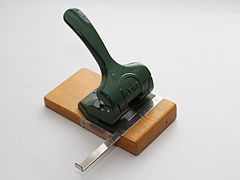
0 Response to "How To Set Up A Hole Puncher"
Post a Comment